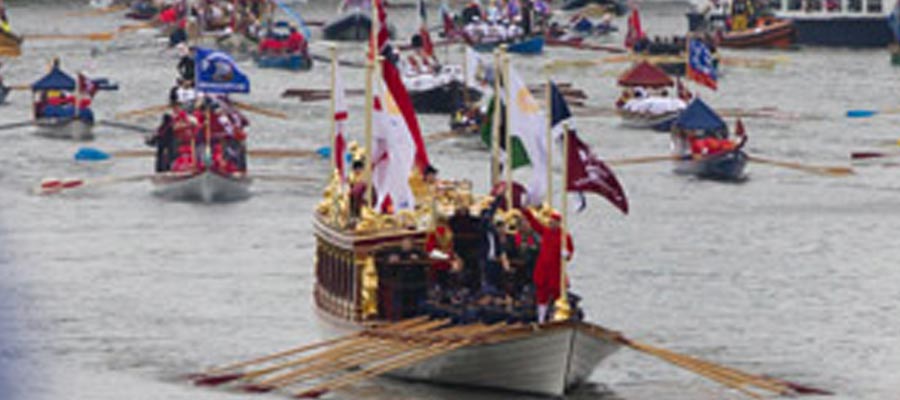So the Queen’s Diamond Jubilee last weekend was just my cup of tea, as they say. On the other hand, if you’re not particularly interested in the Queen or things British, you still could not avoid reading about the Diamond Jubilee or watching it on the news. I’d like to share with you some of the highlights of the 4-day celebration on a day-by-day basis. This is only the second Diamond Jubilee to be celebrated in British history. Even though George III was king for 60 years (1760-1820), he was both mad and blind for the last years of his life, scarcely a call for a celebration.
Saturday, 2 June.
The Queen, who loves horses and her corgis more than anything else, kicked off the first major event of her diamond jubilee weekend by driving onto Epsom racecourse before the Derby to be greeted by 130,000 enthusiastic racegoers.
A spectacular parachute fall by the Red Devils, the British army display team, was staged just before the Queen arrived, with one soldier carrying a huge Union Jack.
The event had a carnival atmosphere, with stiltwalkers dressed as guardsmen complete with scarlet tunics and imitation bearskins to amuse the racegoers. While the Queen was enjoying the racing at Epsom, a 41-gun royal salute echoed across London to mark the anniversary of her coronation.
Sunday, 3 June 2012
The day had begun with six million people around the country attending 10,000 street parties from Devon to Dumfriesshire, almost all of which had gone ahead despite the weather. The one notable exception was Downing Street, where Prime Minister David Cameron and his wife decided to move their party indoors to escape a drenching.
The River Thames Diamond Jubilee Pageant was a maritime parade of 1,000 boats from around the Commonwealth— the largest flotilla seen on the river in 350 years— together with other celebrations along the river banks. Heavy rain started during the event, and the commemorative air force flyover at the end was cancelled due to very low cloud base and bad visibility at ground level.
(Guinness World Records has verified that 670 boats completed the full pageant route from Westminster Bridge to HMS Belfast. This is lower than the 1,000 figure quoted by the organisers because they did not include all the working boats (e.g., police boats), the sailing ships stationed beyond Tower Bridge and the vessels moored along the route (e.g., HMS Belfast)).
The tender from the royal yacht Britannia took the Queen downstream to the royal barge, Spirit of Chartwell, a Thames pleasure cruiser that had been transformed into a handsome ship of state with gilded carvings, Royal Watermen in scarlet ceremonial dress and a royal coat of arms made from half a million gold buttons.
Already on board were the Duke and Duchess of Cambridge and Prince Harry, the only other members of the Royal family given the honour of travelling with the Queen, who wanted her Jubilee to focus on the direct line of succession.
“Spectacular!” the Queen told the Duke of Edinburgh as she surveyed the scene. “So nice, so impressive.”
On a day when the weather could not have been more cruel, more than a million people turned out to line the Thames and give the Sovereign the biggest, albeit the soggiest, party of her 60-year reign.
To repay them for their loyalty, the Queen smiled on through the cold and wet, resisting the joint temptations of an indoor berth and a hot cup of tea to wave non-stop from the windswept deck of the royal barge from start to finish of the Thames Diamond Jubilee pageant.
No one would have blamed the Queen if she had turned out in foul weather gear, but instead she wowed the crowds in an ivory coloured bouclé dress and coat, braided with silk ribbon and with a silk organza frill. Made by the Queen’s dresser Angela Kelly, it was embroidered with gold and silver spots and embellished with crystals to represent diamonds. It seemed to borrow from the Ditchley portrait of Elizabeth I wearing a similarly opulent spotted dress.
As they greeted crowds waiting at the waterside, the Duke said the support was “fantastic” and “wonderful”, adding: “Lots of people turned out today!” The organisers of the 1,000-boat flotilla had insisted it would be “the biggest single live event in the history of the world”, and while historians may squabble over that, no one who was on the banks of the Thames Sunday is likely to live to see anything quite like it again.
The night after the Thames River Pageant, Prince Phillip, the Queens husband feel ill with a bladder infection and was hospitalised. This meant that he would be unable to attend the remainder of the Jubilee events.
Monday, June 4th
Ten thousand members of the public attended a picnic at Buckingham Palace followed by a BBC concert. Performers included Sir Paul McCartney, Stevie Wonder, Sir Elton John, Sir Tom Jones, Annie Lennox, Kylie Mynogue, and Robbie Williams.
At 10.30pm 2,012 beacons were lit across the country, including on each of the four highest peaks in England, Wales, Scotland and Northern Ireland. Tuesday, June 5th
The last day of the Jubilee started with a Thanksgiving service at St Paul’s. Then, while the Queen attended a reception at Mansion House hosted by the Lord Mayor of London, the rest of the Royal Family attended a reception at Guildhall, hosted by the City of London.
At 2.20pm, there was a carriage procession down The Mall, and finally at 3.30pm, the Queen, the Duke of Edinburgh, Prince Charles and Camilla, the Duke and Duchess of Cambridge and Prince Harry appeared on the balcony at Buckingham Palace for an RAF fly past. As everyone says, no country ever does ceremony as well as the British, and this magnificent honor to the Queen certainly proved that statement is not an exaggeration!
Debbie Gambrill
foto zdroj: shuterstock.com

